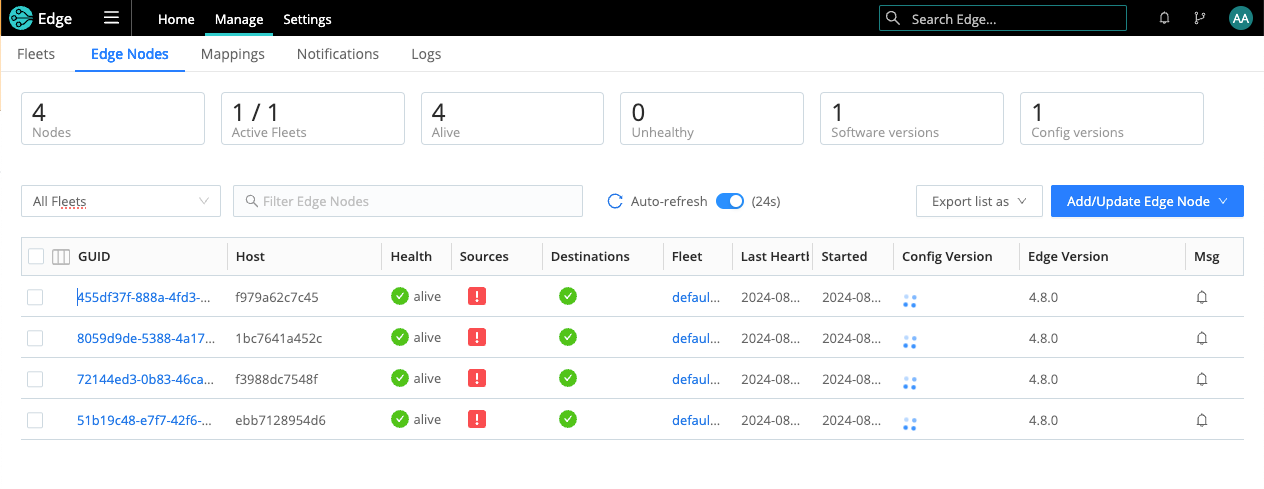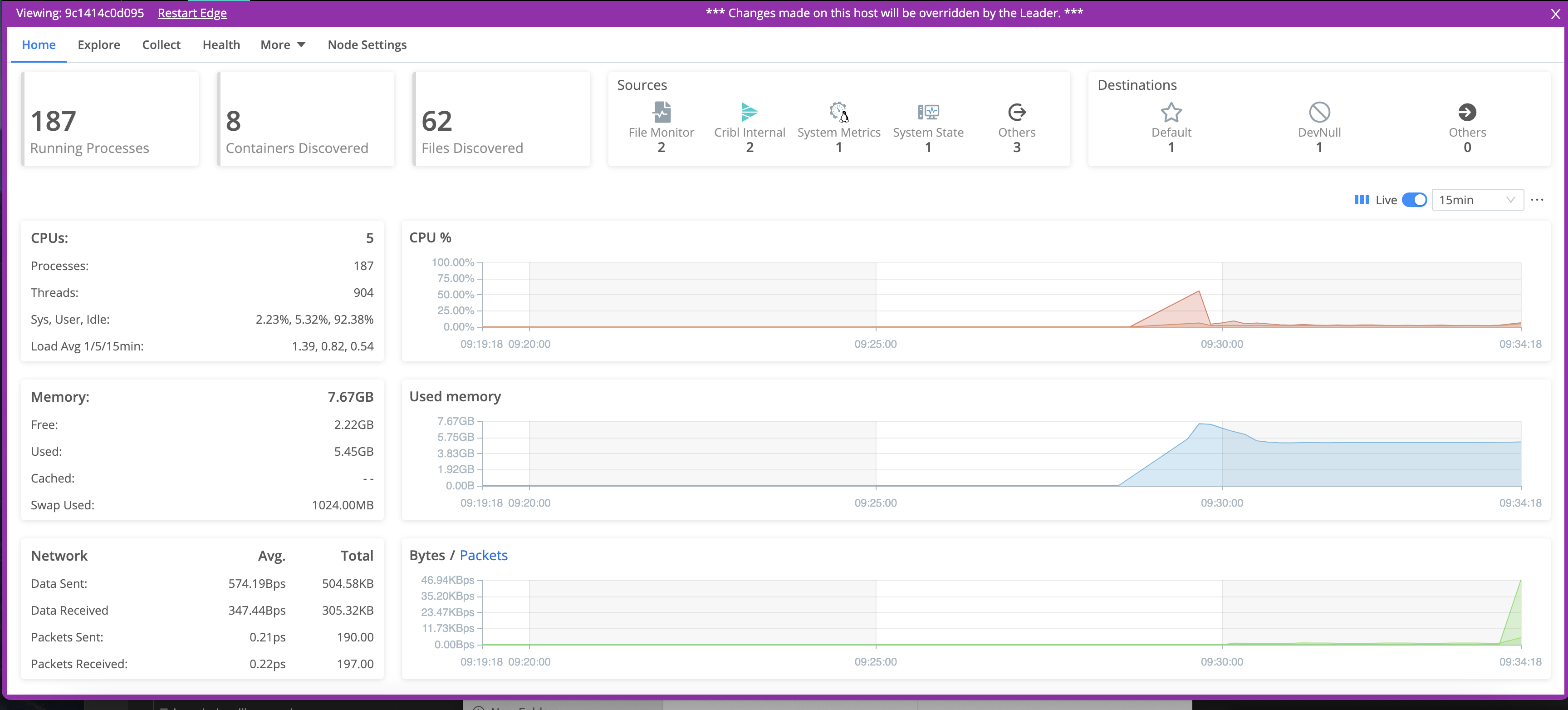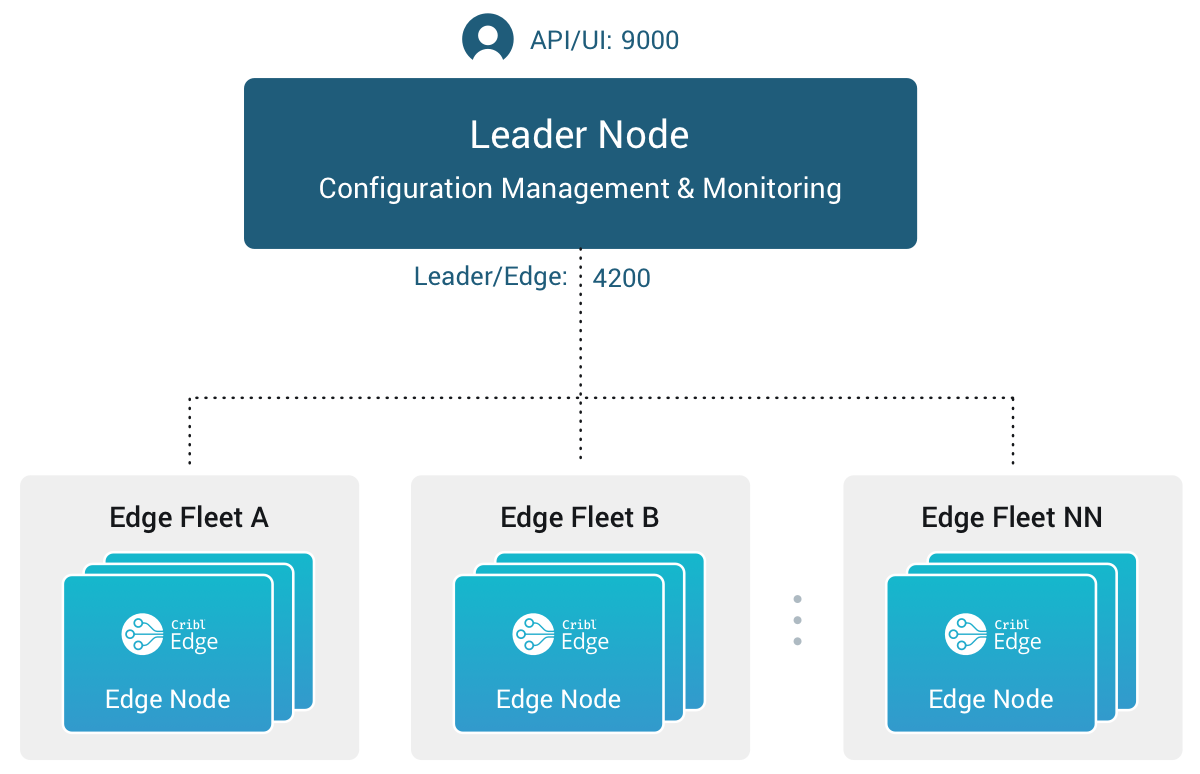These docs are for Cribl Edge 4.8 and are no longer actively maintained.
See the latest version (4.15).
Managing Edge Nodes
You can access the Edge Nodes page if you have an Enterprise or Standard license.
In Cribl Edge, click the Manage tab, then click Edge Nodes. This page contains five upper tabs:
- Fleets
- Edge Nodes
- Mappings
- Notifications
- Logs
Edge Nodes Tab
The Edge Nodes tab on the Manage Edge Nodes page provides status information for each Edge Node in the selected Fleet, as well as a UI for adding and updating Nodes.

Monitor Source and Destination Health on Edge Nodes
You can monitor and track the health of Sources and Destinations associated with an Edge Node from the Edge Nodes tab. This is useful when you have a large number of Nodes, and want to quickly identify and troubleshoot issues with Sources and Destinations.
To sort and filter by health status, select the Sources or Destinations column header.
To open the Node Info drawer and view specific monitoring information, select a health icon. For more information, see Track Data Activity for an Edge Node.
Export a List of Edge Nodes
To export the list of Edge Nodes, click the Export list as drop-down.
Select JSON or CSV as the export file format. If you filter the list
before exporting, the exported list will maintain that filter. You can export the
entire list by removing all filters.
Teleport into an Edge Node
Click the Edge Node GUID link to teleport from the Leader into the Edge Node. Here, you can explore the metrics and log data that the Node has discovered automatically, and can manually discover and explore other data of interest.
You can use the discovered data to perform root-cause analysis, to troubleshoot, and to restart the host. If you want to monitor and troubleshoot the Node data without teleporting, check out the Node Info Panel.
The page displays metadata for the Node, and below it, graphs of system activity. A magenta border indicates you are remotely viewing a host, and identifies the host’s name.
Click Restart Edge to restart the Node. To return to the Manage Edge Nodes page, click the X close button on the upper right.

Changes that you make on an Edge Node will not propagate to the Leader. Also, the Leader will override any changes that you make directly on a Node.
Add Tags to Edge Nodes in Teleport View
You can add tags to an Edge Node you’ve teleported into. Tags help the Leader map an Edge Node to a Fleet. Note that changing the tags on a Node can cause the Leader to map the Node into a new Fleet.
- Teleport into an Edge Node.
- Navigate to Node Settings then Distributed Settings.
- Enter tags for this Node and select Save.
In Cribl.Cloud, you must accept the confirmation modal. Changing the tags on an Edge Node can affect the Fleet that the Leader maps it into.
Add/Update Edge Nodes
You can use the Add/Update Edge Node control at upper right to update an existing Node, or to add a new Node by generating a bootstrap script. Cribl Edge admins can use the UI to concatenate and copy/paste the bootstrap script, automating several steps below. You can use an adjacent option to grab a script that updates an Edge Node’s Fleet assignment. You also have the option of generating a bootstrap script for the following Edge Nodes:
- Docker: For details, see Running in a Docker Container.
- Kubernetes: For details, see Deploying via Kubernetes.
- Linux: For details, see Installing Cribl Edge on Linux.
- Windows: For details, see Installing Cribl Edge on Windows.

The Update option in the UI adjusts the Leader connection details for the currently installed software. To upgrade the Edge Node - that is, install a newer version of the software - see Upgrading.
Edge Node Updates Using Fleet Version Settings
The Add/Update Edge Node command ensures accurate updates by using the specified Target Software Version for your Fleet, enhancing the reliability and consistency of updates across all supported environments: Docker, Kubernetes, Linux, and Windows.
For Docker and Kubernetes:
If you don’t specify a target version, the command uses the Leader version’s image and version flag respectively, by default.
If you specify a target version, the command parses the Fleet version and maps it to the appropriate CDN URL or version flag.
For Linux environments:
- The existing script behavior from the Leader manages the updates unless you specify a target version, in which case the script uses that version.
For Windows:
- The default behavior uses the Leader Version from the CDN, while specifying a target version directs the command to parse the Fleet version and map it for MSI download via the CDN.
This mechanism ensures a more consistent and reliable deployment process, maintaining version control and improving update accuracy across all environments.
Add/Bootstrap a New Edge Node
All Edge Nodes’ hosts must enable ongoing outbound communication to the Leader’s port 4200, to enable the Leader to manage the Nodes. While the bootstrap script runs, firewalls on each Nodes’s host must also allow outbound communication on the following ports:
- Port 443 to
https://cdn.cribl.io. - Port 443 to a Cribl.Cloud Leader.
- Port 9000 to an on-prem Leader.
The details below differ slightly depending on which deployment option you select.
From Cribl Edges’s top nav, select Manage > Edge Nodes.
On the resulting Edge Nodes tab, click Add/Update Edge Node at the upper right.
Select the deployment option as shown in the composite screenshots below.
In the resulting modal, the Install package location defaults to
Cribl CDN. If desired, change this toDownload URL.As needed, correct the target Fleet, as well as the Leader hostname/IP (URI).
As needed, correct the User and User Group to run Cribl as. Defaults to
cribl.As needed, correct the Installation directory. Defaults to
/opt/cribl.Optionally, add Tags that you can use for filtering and grouping in Cribl Edge. Use a tab or hard return between (arbitrary) tag names.
Copy the resulting script to your clipboard.
Click either Done or X to close the modal.
Paste the script onto your Edge Node’s command line and execute it, to add the Edge Node.
Troubleshooting the Display
If you see unexpected results on the Edge Nodes tab, keep in mind that:
- Edge Nodes that miss 5 heartbeats, or whose connections have closed for more than 30 seconds, will be removed from the list.
- For a newly created Fleet, the Config Version column can show an indefinitely spinning progress spinner for that Fleet. This happens because the Edge Nodes are polling for a config bundle that has not yet been deployed. To resolve this, click the Deploy option to force a deploy.
- For details on collocating multiple Cribl products, see Cribl Edge and Cribl Stream on the Same Host.
- For details on overriding default ports, see Overriding Default Ports.
How Edge Nodes and Leader Nodes Work Together
The Leader Node has two primary roles:
Serves as a central location for Edge Nodes’ operational metrics. The Leader ships with a monitoring console that has a number of dashboards, covering almost every operational aspect of the deployment.
Serves as a central location for authoring, validating, deploying, and synchronizing configurations across Fleets.

Network Port Requirements (Defaults)
- UI access to Leader Node: TCP 9000.
- Edge Node to Leader Node: TCP 4200. Used for Heartbeat/Metrics/Leader requests/notifications to clients (such as live captures, teleporting, status updates, and config bundle notifications).
- Edge Node to Leader Node: HTTPS 4200. Used for config bundle downloads.
- Edge Node bootstrapping/update: TCP 443.
Leader/Edge Node Communication
Edge Nodes will send a heartbeat to the Leader every 60 seconds. This heartbeat includes information about the Nodes and a set of current system metrics. The heartbeat payload includes facts - such as hostname, IP address, GUID, tags, environment variables, and current software/configuration version - that the Leader tracks with the connection.
When an Edge Node checks in with the Leader:
- It sends a heartbeat to Leader with “facts” about itself.
- The Leader uses Edge Node’s facts and Mapping Rules to map it to a Fleet.
- The Edge Node pulls its Fleet’s updated configuration bundle, if necessary.
The Leader is unaware of Edge Nodes’ platforms (such as Linux or Windows) within a Fleet. So the ConfigHelper omits platform-specific limitations. Therefore, when you manage Edge Nodes on heterogeneous platforms, create a Windows-specific Fleet and mapping. See Managing Edge Nodes on Multiple Platforms.
Config Bundle Management
Config bundles are compressed archives of all config files and associated data that an Edge Node needs to operate. The Leader creates bundles upon Deploy, and manages them as follows:
- Bundles are wiped clean on startup.
- While running, at most 5 bundles per group are kept.
- Bundle cleanup is invoked when a new bundle is created.
The Edge Node pulls bundles from the Leader and manages them as follows:
- Last 5 bundles and backup files are kept.
- At any point in time, all files created in the last 10 minutes are kept.
- Bundle cleanup is invoked after a reconfigure.
Bundle in S3
You can store bundles in an AWS S3 bucket to reduce the Leader load. This offloads bundle distribution from the Leader to your designated S3 bucket. Edge Nodes will pull bundles directly from S3, minimizing Leader strain.
You can configure bundling in S3 through the following ways:
- UI: When configuring Leader Settings on a Leader Node, specify an S3 bucket (format:
s3://${bucket}) for remote bundle storage in the S3 Bundle Bucket URL field. - YAML: In the
instance.ymlconfig file, specify the S3 bucket inmaster.configBundles.remoteUrl. - Environment Variable: Use the
CRIBL_DIST_LEADER_BUNDLE_URLenvironment variable.
Optimized Bundle Delivery from S3
Cribl prioritizes efficient updates for Edge Nodes, regardless of their network environment. Here’s how:
- Direct S3 Downloads (Preferred): Cribl prioritizes downloading upgrade packages directly from Amazon S3 (S3) whenever possible, ensuring efficient updates for Edge Nodes connected to Cribl.Cloud or an on-premise Leader. The source is specified in the Leader’s Global Settings > Upgrades > Package source setting.
- Automatic Failover: If the S3 download fails, a built-in failover automatically retrieves the bundle from the Leader itself (port
4200). This redundancy guarantees updates even in challenging network environments, including private networks with restricted internet access. For these networks, Cribl prioritizes a CDN download before reverting to the Leader Node as a final resort. - Allowlist S3 Access (Optional): To further optimize downloads for Edge Nodes with internet access, consider adding the S3 access (
*.s3.amazonaws.com) to the allowlist in your firewalls or proxies (due to non-static S3 addresses). This proactive step helps avoid disruptions.
This multi-step approach ensures efficient and reliable Edge Node updates in various network configurations.





